In 2017, amendments were made to the procedure for drawing up electrical bills, which are defined as spending on general household needs (according to the accepted classification - "ONE for electricity"). After this adjustment, these costs were categorized as the costs of maintaining the property common to the entire city house. The upper bar of these charges (or consumption standard) is limited by the limits, the value of which was approved in the same 2017.
What is ONE for electricity
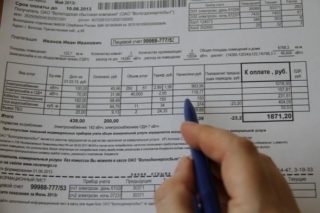
For example, we can consider the distribution of consumer goods within an apartment building. They are conditionally divided between two main items of expenditure:
- Payment by each tenant for electrical energy consumed within only his own apartment.
- The total cost of the entire home, shared equally among all tenants.
The second component is the very general household needs that require more detailed consideration.
What's in this category
- common corridors, landings and vestibules;
- areas in front of the driveway;
- basements in the house and attics.
This also includes the costs of paying for the operation of elevators, intercoms, and surveillance cameras.
ODN also includes payments for power supply and maintenance of elements of communication devices (amplifiers for cable TV and Internet networks, for example).
The list is supplemented by the cost of power supply for alarm systems installed in the stairwell, general antenna amplifiers, as well as pumps and other equipment.
When calculating ONE, the so-called "technological losses" associated with non-productive energy consumption are taken into account. This means not only the light bulbs left not turned off, but also poor-quality contacts, on which energy is consumed in the form of heat dissipated into space.
Accrual rate
In accordance with the laws adopted in the Russian Federation, the payment for electricity, which is included in the item of utility costs, is charged from the collective consumer at fixed tariffs. The exact figures for the ODN standards for light in an apartment building are recognized from the list, which takes into account the composition of the common property in it (SOI). Information on this property is provided on the Internet at the websites of specific energy companies. To get acquainted with it, you just need to select your city, and then download the documents displayed in the issue line.
These figures alone are not enough to obtain the final result for the electricity of the ODN. To calculate it, you will have to use a special formula. It is important to pay attention to the fact that in the tables for a specific housing and communal services, two numbers are usually given: one with regard to the payment for the elevator, and the second without it. Further actions depend on the goals set by the user.
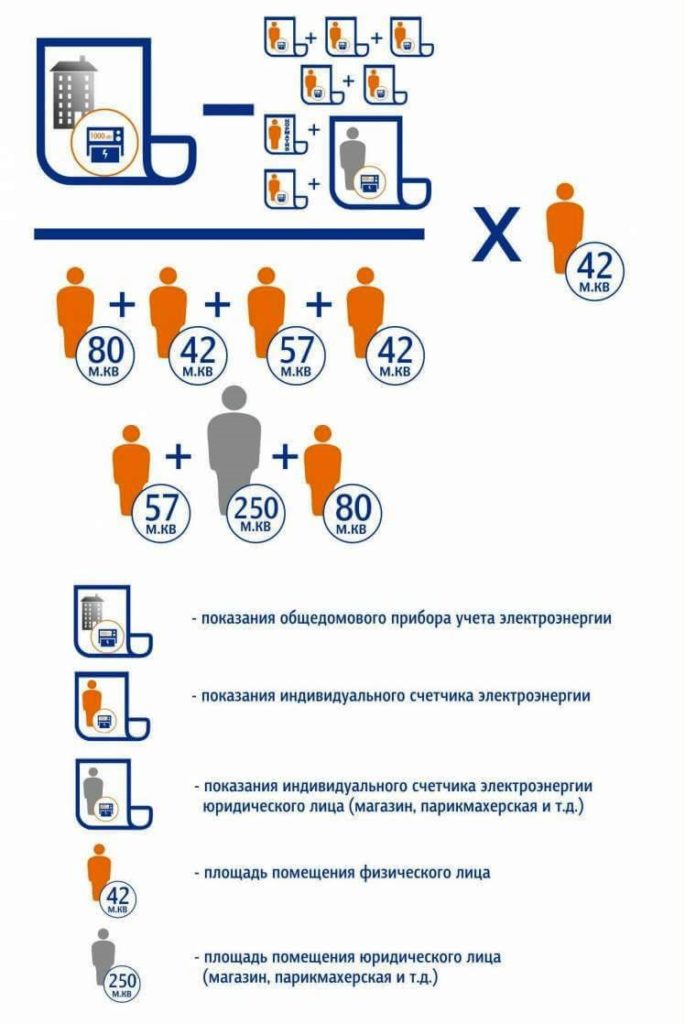
How to calculate ONE for electricity

Before counting ONE in a city house by a meter, you will need to familiarize yourself with the formula for calculating it. It is based on the total footage and the tariff applied in the area.For the current 2019, the calculation technique and the formula itself used in this case have practically not changed. When using it, it is assumed that a common metering device is installed in the city house, and also that each apartment has its own individual meter.
In this case, the calculation formula by which the payment should be calculated takes the following form:
Vi one = (V vol - Σu Vu non - Σv Vv residential - Σu Vw residential - V cr) × (Si ∕ S vol)where
- V about - the numbers of indications taken from the meter common for the house,
- Vu nezh - the amount of energy consumed in premises considered non-residential,
- Vv lived. - consumption of a separate dwelling that does not have its own meter,
- Vw living room - consumption in apartments equipped with an individual metering device,
- V cr - part of the energy consumed for heating needs and hot water supply (for houses that are not connected to centralized networks).
Si represents the area of an individual apartment, and S - the total footage of all such premises in a particular house.
An example of calculation for a multi-storey building
From the sources, the normative value of electricity consumption at ODN is found for residents of apartment buildings with common appliances installed in them. According to tariffs in force in most regions of the Russian Federation, this figure is 3.94 kilowatt / hour (based on 1 sq. M. Of common area per month).
Let the footage of all premises that are part of the common property of this residential building be 1400 square meters. The total area of a separate apartment is, for example, 60 sq. meters. The footage of all residential and non-residential premises in this apartment building corresponds to the figure of 2400 sq. meters.
If we calculate the amount that will have to be paid to all tenants according to ONE, it will be equal to 3.94x1400 x 60/2400 = 140.0 kW / h (approximately). Applying to the result obtained the formula for recalculating this expense item for one apartment, we get: 140.461x1.936 = 271.93 rubles.
The coefficient 1.936 is determined in a practical way for a typical apartment building.
In real conditions, the amount of payment for ONE according to the original standard (when access meters are either faulty or absent) is much higher than the same indicator obtained with a serviceable general device. Therefore, almost all residents of an apartment building are interested in installing and maintaining it in working order.
Ways to reduce ARI
Unjustified costs in this case are manifested in the form of heat losses, dissipated into the surrounding space idle.
To reduce the costs of ONE in any apartment building, the following actions must be taken:
- install in public areas with lighting (in corridor spans and on sites) automatic switches - photo sensors or presence sensors;
- if it is impossible to use technical means, organize a mode of individual use of light;
- collectively pay for the work of an electrician to check all connections in the general wiring and maintain contacts in good condition.
If the wiring is very worn out, it is necessary to replace the worn-out areas with a new cable.
All of the above measures will help to maintain expenditures on ODN within the normalized indicators.
If the volume is ONE negative
If the amount presented for payment turned out to be negative - the residents of the house were charged a larger amount than actually consumed - the difference is necessarily debited from their accounts. When this difference is positive, it is equally distributed among all residents of the house who are obliged to pay for it according to the ODN receipt.
The situation with a negative balance on the ONE usually develops in cases where there were no meters in several apartments of a particular house. At the same time, the payment accrued to the tenants of these apartments also includes general building costs, although the actual consumption under this item is less. The resulting negative difference must be recalculated by the electricity supplier by dividing the surplus (overpayment) between all apartment owners.
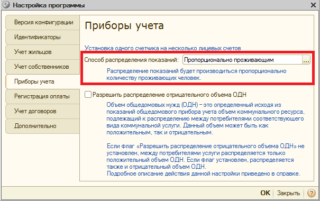
When recalculating, the flow rate is taken as a basis, proportional to the number of residents living in an apartment without an electric meter or the size of its total area in square meters. m. The specified procedure is clearly spelled out in article 354 of the government decree. On its basis, after a negative balance is found in the receipt for this utility service, it is immediately concluded that this is a recalculation of the payment.
This case can be clearly explained by the following example. Let the difference between the readings of the general electricity meter and those taken from all apartments was 130 kW / h. If the total number of residents in this house is 150 people, the difference in payment found is distributed as follows: -130/150 = -0.87 kWh. Suppose that in an apartment with three residents registered in it, 100 kW / hour have been consumed for the current month (this number does not include housing without a meter). As a result of the recalculation, the volume of energy consumed by each personal owner will decrease by 3x0.87 = 2.61 kW / h. If this rule (as well as all others) is not respected when the ONE is calculated, deprived tenants have the right to resolve the issue through contacting local courts. After the relevant authorities have made a decision in favor of the applicant, it will also be possible to cancel it only through the court.
Most of the ONEs that have to be paid to residents of the house can be attributed to the cost of lighting the entrances and the area around the house. Following on this indicator are various types of equipment (heating pumps and elevators). A smaller share is the cost of electrical equipment used in the repair work.

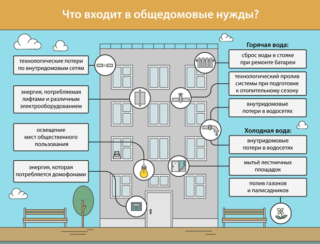
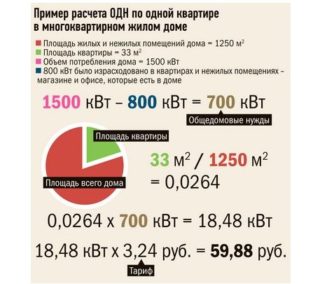
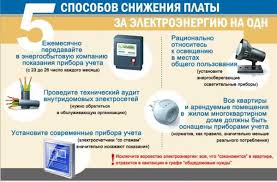
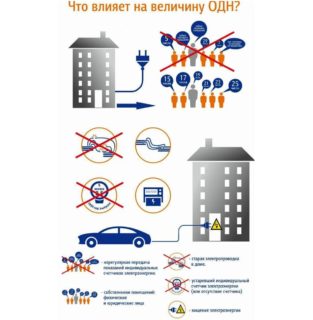








It all depends on what area of non-residential premises the Criminal Code takes. Our CC includes areas of both the technical underground and the attic area, although there was never any lighting there. So we pay for what is not.
When our government begins to deal with the Criminal Code, do you really like this chaos? Management companies do not want to work, and bills for housing and utility services are sent regularly. Isn't it time to stop the rise in prices?
Our Criminal Code generally dismissed the janitors, technicians, locksmiths, painting in favor of a certain cleaning company, now the entrances are not cleaned at all, but they take water on Ku regularly, exits from the entrances are removed once a month, the tenants themselves, or rather 70-year-olds, are cleaned, but money for maintenance is regularly taken
Be an owner in your soul, and not on paper, then the Criminal Code will work fine.